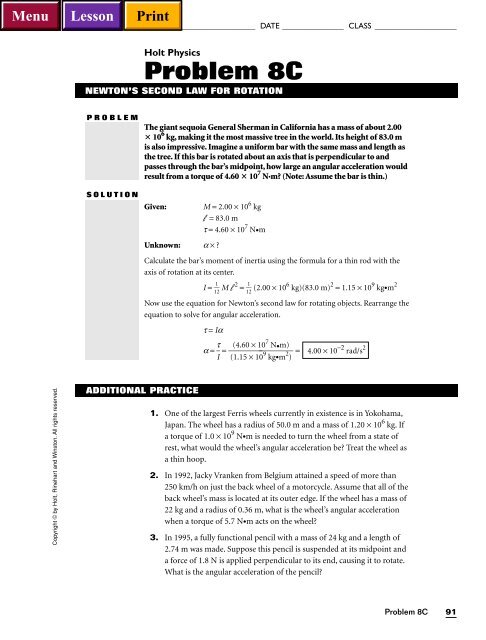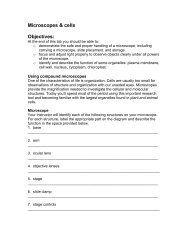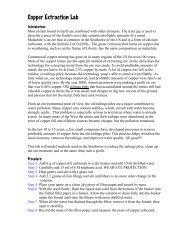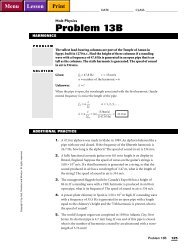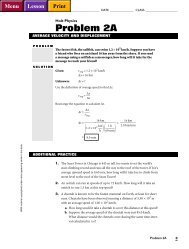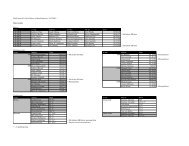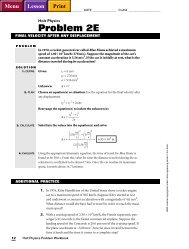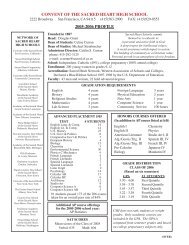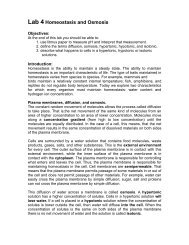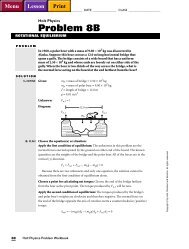Problem 8C
Problem 8C
Problem 8C
Create successful ePaper yourself
Turn your PDF publications into a flip-book with our unique Google optimized e-Paper software.
NAME ______________________________________ DATE _______________ CLASS ____________________<br />
Holt Physics<br />
<strong>Problem</strong> <strong>8C</strong><br />
NEWTON’S SECOND LAW FOR ROTATION<br />
PROBLEM<br />
SOLUTION<br />
The giant sequoia General Sherman in California has a mass of about 2.00<br />
10 6 kg, making it the most massive tree in the world. Its height of 83.0 m<br />
is also impressive. Imagine a uniform bar with the same mass and length as<br />
the tree. If this bar is rotated about an axis that is perpendicular to and<br />
passes through the bar’s midpoint, how large an angular acceleration would<br />
result from a torque of 4.60 10 7 N•m (Note: Assume the bar is thin.)<br />
Given: M = 2.00 × 10 6 kg<br />
l = 83.0 m<br />
t = 4.60 × 10 7 N•m<br />
Unknown: a × <br />
Calculate the bar’s moment of inertia using the formula for a thin rod with the<br />
axis of rotation at its center.<br />
1<br />
I = ⎯⎯ 1<br />
M<br />
2 l 2 1<br />
= ⎯⎯ 1<br />
(2.00 × 10 6 kg)(83.0 m) 2 = 1.15 × 10 9 kg•m 2<br />
2<br />
Now use the equation for Newton’s second law for rotating objects. Rearrange the<br />
equation to solve for angular acceleration.<br />
t = Ia<br />
a = ⎯ t 7<br />
I ⎯ = ⎯ ( 4.60<br />
× 10<br />
N•<br />
m)<br />
⎯ 9 2 = 4.00 × 10 −2 rad/s 2<br />
( 1.15<br />
× 10<br />
kg•<br />
m )<br />
Copyright © by Holt, Rinehart and Winston. All rights reserved.<br />
ADDITIONAL PRACTICE<br />
1. One of the largest Ferris wheels currently in existence is in Yokohama,<br />
Japan. The wheel has a radius of 50.0 m and a mass of 1.20 × 10 6 kg. If<br />
a torque of 1.0 × 10 9 N•m is needed to turn the wheel from a state of<br />
rest, what would the wheel’s angular acceleration be Treat the wheel as<br />
a thin hoop.<br />
2. In 1992, Jacky Vranken from Belgium attained a speed of more than<br />
250 km/h on just the back wheel of a motorcycle. Assume that all of the<br />
back wheel’s mass is located at its outer edge. If the wheel has a mass of<br />
22 kg and a radius of 0.36 m, what is the wheel’s angular acceleration<br />
when a torque of 5.7 N•m acts on the wheel<br />
3. In 1995, a fully functional pencil with a mass of 24 kg and a length of<br />
2.74 m was made. Suppose this pencil is suspended at its midpoint and<br />
a force of 1.8 N is applied perpendicular to its end, causing it to rotate.<br />
What is the angular acceleration of the pencil<br />
<strong>Problem</strong> <strong>8C</strong> 91
NAME ______________________________________ DATE _______________ CLASS ____________________<br />
4. The turbines at the Grand Coulee Third Power Plant in the state of<br />
Washington have rotors with a mass of 4.07 × 10 5 kg and a radius of<br />
5.0 m each. What angular acceleration would one of these rotors have if<br />
a torque of 5.0 × 10 4 N•m were applied Assume the rotor is a uniform<br />
disk.<br />
5. J. C. Payne of Texas amassed a ball of string that had a radius of 2.00 m.<br />
Suppose a force of 208 N was applied tangentially to the ball’s surface<br />
in order to give the ball an angular acceleration of 3.20 × 10 –2 rad/s 2 .<br />
What was the ball’s moment of inertia<br />
6. The heaviest member of British Parliament ever was Sir Cyril Smith.<br />
Calculate his peak mass by finding first his moment of inertia from the<br />
following situation. If Sir Cyril were to have ridden on a merry-goround<br />
with a radius of 8.0 m, a torque of 7.3 × 10 3 N•m would have<br />
been needed to provide him with an angular acceleration of 0.60 rad/s 2 .<br />
7. In 1975, a centrifuge at a research center in England made a carbonfiber<br />
rod spin about its center so fast that the tangential speed of the<br />
rod’s tips was about 2.0 km/s. The length of the rod was 15.0 cm. If it<br />
took 80.0 s for a torque of 0.20 N•m to bring the rod to rest from its<br />
maximum speed, what was the rod’s moment of inertia<br />
8. The largest tricycle ever built had rear wheels that were almost 1.70 m<br />
in diameter. Neglecting the mass of the spokes, the moment of inertia<br />
of one of these wheels is equal to that of a thin hoop rotated about its<br />
symmetry axis. Find the wheel’s moment of inertia and its mass if a<br />
torque of 125 N•m is applied to the wheel so that in 2.0 s the wheel’s<br />
angular speed increases from 0 rad/s to 12 rad/s.<br />
9. In 1990, a cherry pie with a radius of 3.00 m and a mass of 17 × 10 3 kg<br />
was baked in Canada. Suppose the pie was placed on a light rotating<br />
platform attached to a motor. If this motor brought the angular speed<br />
of the pie from 0 rad/s to 3.46 rad/s in 12 s, what was the torque the<br />
motor must have produced Assume the mass of the platform was negligible<br />
and the pie was a uniformly solid disk.<br />
10. In just over a month in 1962, a shaft almost 4.00 × 10 8 m deep and with<br />
a radius of 4.0 m was drilled in South Africa. The mass of the soil taken<br />
out was about 1.0 × 10 8 kg. Imagine a rigid cylinder with a mass, radius,<br />
and length equal to these values. If this cylinder rotates about its<br />
symmetry axis so that it undergoes a constant angular acceleration<br />
from 0 rad/s to 0.080 rad/s in 60.0 s, how large a torque must act on the<br />
cylinder<br />
11. In 1993, a bowl in Canada was filled with strawberries. The mass of the<br />
bowl and strawberries combined was 2390 kg, and the moment of inertia<br />
about the symmetry axis was estimated to be 2.40 × 10 3 kg•m 2 .Suppose<br />
a constant angular acceleration was applied to the bowl so that it<br />
made its first two complete rotations in 6.00 s. How large was the<br />
torque that acted on the bowl<br />
Copyright © by Holt, Rinehart and Winston. All rights reserved.<br />
92<br />
Holt Physics <strong>Problem</strong> Workbook
NAME ______________________________________ DATE _______________ CLASS ____________________<br />
12. A steel ax with a mass of 7.0 × 10 3 kg and a length of 18.3 m was made<br />
in Canada. If Paul Bunyan were to take a swing with such an ax, what<br />
torque would he have to produce in order for the blade to have a tangential<br />
acceleration of 25 m/s 2 Assume that the blade follows a circle<br />
with a radius equal to the ax handle’s length and that nearly all of the<br />
mass is concentrated in the blade.<br />
Copyright © by Holt, Rinehart and Winston. All rights reserved.<br />
<strong>Problem</strong> <strong>8C</strong> 93
Givens<br />
Solutions<br />
7. m = 449 kg<br />
Apply the first condition of equilibrium to solve for F 2 .<br />
l = 5.0 m<br />
F 1 + F 2 − mg = 0<br />
F 1 = 2.70 × 10 3 N<br />
F 2 = mg − F 1<br />
g = 9.81 m/s 2 F 2 = (449 kg)(9.81 m/s 2 ) − 2.70 × 10 3 N = 4.40 × 10 3 N − 2.70 × 10 3 N = 1.70 × 10 3 N<br />
Apply the second condition of equilibrium, using the left end of the platform as the<br />
pivot point.<br />
F 2 l − m g d = 0<br />
F (1.70 × 10 3 2 l<br />
N)(5.0 m)<br />
d = ⎯ = ⎯⎯⎯<br />
mg (449 kg)(9.81 m/s 2 )<br />
d =<br />
1.9 m from the platform’s left end<br />
8. m 1 = 414 kg<br />
Apply the first condition of equilibrium to solve for F 2 .<br />
l = 5.00 m<br />
F 1 + F 2 − m 1 g − m 2 g = 0<br />
m 2 = 40.0 kg<br />
F 2 = m 1 g + m 2 g − F 1 = (m 1 + m 2 ) g − F 1<br />
F 1 = 50.0 N<br />
F 2 = (414 kg + 40.0 kg)(9.81 m/s 2 ) − 50.0 N = (454 kg)(9.81 m/s 2 ) − 50.0 N = 4.45 ×<br />
g = 9.81 m/s 2 10 3 N − 50.0 N<br />
F 2 = 4.40 × 10 3 N<br />
Apply the second condition of equilibrium, using the supported end (F 1 ) of the stick<br />
as the rotation axis.<br />
F 2 d − m 1 g <br />
− m 2 g l = 0<br />
l<br />
⎯2<br />
⎯m 1<br />
⎯ + m 2<br />
2 g l<br />
d = ⎯⎯ = F2<br />
⎯414 kg<br />
⎯ + 40.0 kg<br />
2 <br />
(9.81 m/s 2 )(5.0 m)<br />
⎯⎯⎯⎯<br />
4.40 × 10 3 N<br />
(207 kg + 40.0 kg)(9.81 m/s 2 )(5.00 m)<br />
d = ⎯⎯⎯⎯ =<br />
4.40 × 10 3 N<br />
(247 kg)(9.81 m/s 2 )(5.00 m)<br />
⎯⎯⎯<br />
4.40 × 10 3 N<br />
II<br />
Copyright © by Holt, Rinehart and Winston. All rights reserved.<br />
Additional Practice <strong>8C</strong><br />
1. R = 50.0 m<br />
M = 1.20 × 10 6 kg<br />
t = 1.0 × 10 9 N •m<br />
2. M = 22 kg<br />
R = 0.36 m<br />
t = 5.7 N •m<br />
d = 2.75 m from the supported end<br />
a = ⎯ t I ⎯ = ⎯ t 1.0 × 10 9 N •m<br />
⎯<br />
MR 2 = ⎯⎯⎯<br />
(1.20 × 10 6 kg)(50.0 2 )<br />
a = 0.33 rad/s 2<br />
a = ⎯ t I ⎯ = ⎯ t 5.7 N•m<br />
⎯<br />
MR 2 = ⎯⎯<br />
(22 kg)(0.36 m)<br />
2<br />
a = 2.0 rad/s 2<br />
Section Two—<strong>Problem</strong> Workbook Solutions II Ch. 8–5
Givens<br />
3. M = 24 kg<br />
l = 2.74 m<br />
F = 1.8 N<br />
Solutions<br />
The force is applied perpendicular to the lever arm, which is half the pencil’s length.<br />
Therefore,<br />
l<br />
t = F d (sin q) = F ⎯2<br />
⎯<br />
F<br />
a = ⎯ t (1.8 N) <br />
⎯ 2.7 4m<br />
⎯l<br />
I ⎯ = 2<br />
=<br />
2<br />
⎯<br />
⎯ ⎯⎯<br />
1<br />
1<br />
⎯⎯ M ⎯⎯ (24 kg)(2.74 m) 2<br />
12<br />
l 2<br />
12<br />
a = 0.16 rad/s 2<br />
4. M = 4.07 × 10 5 kg<br />
R = 5.0 m<br />
t = 5.0 × 10 4 N •m<br />
a = ⎯ t I ⎯⎯ =<br />
t<br />
⎯<br />
1<br />
⎯<br />
2 ⎯ MR 2<br />
(5.0 × 10 4 N •m)<br />
a = ⎯⎯⎯<br />
1<br />
⎯<br />
2 ⎯ (4.07 × 10 5 kg)(5.0 m) 2<br />
II<br />
a = 9.8 × 10 −3 rad/s 2<br />
5. R = 2.00 m<br />
F = 208 N<br />
a = 3.20 × 10 −2 rad/s 2<br />
The force is applied perpendicular to the lever arm, which is the ball’s radius.<br />
Therefore,<br />
t = F d (sin q) = F R<br />
t FR T = ⎯ ⎯ = ⎯⎯ = a a<br />
I = 1.30 × 10 4 kg •m 2<br />
(208 N)(2.00 m)<br />
⎯⎯<br />
3.20 × 10 −2 rad/s 2<br />
6. r = 8.0 m<br />
t<br />
I = ⎯ ⎯ = mr<br />
2<br />
t = 7.3 × 10 3 N•m<br />
a<br />
7.3 × 10 3 N•m<br />
a = 0.60 rad/s 2 I = ⎯⎯ = 1.2 × 10 4 kg •m 2<br />
0.60 rad/s<br />
2<br />
7. v t,i = 2.0 km/s<br />
l = 15.0 cm<br />
∆t = 80.0 s<br />
t =−0.20 N•m<br />
v t,f = 0 m/s<br />
m = ⎯ r<br />
I2 ⎯ = 1.2 × 10 4 kg•m 2<br />
⎯⎯ = 1.9 × 102 kg<br />
(8.0 m)<br />
2<br />
t t<br />
I = ⎯ ⎯ = ⎯⎯ = a<br />
<br />
⎯<br />
<br />
−<br />
d<br />
⎯<br />
l<br />
⎯ ∆t<br />
I =<br />
<br />
⎯ w w<br />
⎯ i f∆ t <br />
−0.20 N•m<br />
=<br />
<br />
0 m/s − 2.0 × 10 3 ⎯⎯⎯ m/s<br />
<br />
0m<br />
⎯ <br />
(80.0 s)<br />
⎯0.15 2<br />
I = 6.0 × 10 −4 kg •m 2<br />
v t,f − v t,i<br />
2<br />
t<br />
−0.20 N•m<br />
3<br />
⎯ −2.0<br />
× 10<br />
m/s<br />
⎯<br />
(0.075<br />
m)<br />
( 80.0<br />
s) <br />
Copyright © by Holt, Rinehart and Winston. All rights reserved.<br />
II Ch. 8–6<br />
Holt Physics Solution Manual
Givens<br />
8. R = ⎯ 1.7 0m ⎯ = 0.85 m<br />
2<br />
t = 125 N •m<br />
∆t = 2.0 s<br />
w i = 0 rad/s<br />
w f = 12 rad/s<br />
Solutions<br />
t<br />
I = ⎯ ⎯ = MR<br />
2<br />
a<br />
t t<br />
125 N •m 125 N•m<br />
I = ⎯ ⎯ = ⎯⎯ = ⎯⎯⎯ = ⎯<br />
a<br />
<br />
6.0 rad/s<br />
2<br />
s − 0rad/s<br />
<br />
⎯ w f − w<br />
⎯ i<br />
⎯12<br />
⎯<br />
∆t<br />
<br />
rad/2 .0 s <br />
I = 21 kg •m 2 21 kg•m<br />
M = ⎯<br />
R<br />
I2 2<br />
⎯ = ⎯ = 29 kg<br />
(0.85 m)<br />
2<br />
9. R = 3.00 m<br />
M = 17 × 10 3 kg<br />
w i = 0 rad/s<br />
w f = 3.46 rad/s<br />
∆t = 12 s<br />
10. R = 4.0 m<br />
M = 1.0 × 10 8 kg<br />
w i = 0 rad/s<br />
w f = 0.080 rad/s<br />
∆t = 60.0 s<br />
t = I a = ⎯1 2 ⎯<br />
t =<br />
MR 2 <br />
⎯ w f<br />
−<br />
∆<br />
⎯ w i<br />
t<br />
(17 × 10 3 kg)(3.00 m) 2 (3.46 rad/s − 0 rad/s)<br />
⎯⎯⎯⎯⎯<br />
(2)(12 s)<br />
t = Ia = ⎯1 2 ⎯<br />
t =<br />
MR 2 <br />
⎯ w f<br />
−<br />
∆<br />
⎯ w i<br />
t<br />
(1.0 × 10 8 kg)(4.0 m) 2 (0.080 rad/s − 0 rad/s)<br />
⎯⎯⎯⎯⎯<br />
(2)(60.0 s)<br />
= 2.2 × 10 4 N•m<br />
= 1.1 × 10 6 N •m<br />
II<br />
Copyright © by Holt, Rinehart and Winston. All rights reserved.<br />
11. I = 2.40 × 10 3 kg•m 2<br />
∆q = 2(2p rad) = 4p rad<br />
∆t = 6.00 s<br />
w i = 0 rad/s<br />
12. m = 7.0 × 10 3 kg<br />
r = 18.3 m<br />
a t = 25 m/s 2<br />
∆q = w i ∆t + ⎯ 1 2 ⎯ a ∆t 2<br />
Because w i = 0,<br />
∆q = ⎯ 1 2 ⎯ a∆t 2<br />
a = ⎯ 2 ∆q<br />
⎯<br />
∆t 2<br />
t = Ia = ⎯ 2 I ∆q<br />
(2)(2.40 × 10 3 kg•m 2 )(4p rad)<br />
⎯ 2 = ⎯⎯⎯⎯<br />
∆t<br />
(6.00 s) 2<br />
t = 1.68 × 10 3 N •m<br />
t = Ia = (mr 2 )⎯ a t<br />
⎯ = mra t<br />
r<br />
t = (7.0 × 10 3 kg)(18.3 m)(25 m/s 2 )<br />
t = 3.2 × 10 6 N •m<br />
Section Two—<strong>Problem</strong> Workbook Solutions II Ch. 8–7


